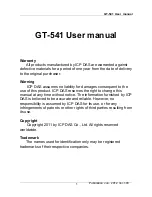
Wireless Settings
8-3
8
Note:
If you experience poor performance, you may be encountering interference from
another wireless device. Try changing the channel, as this may eliminate
interference and increase performance. Channels 1, 6, and 11, as the three
non-overlapping channels in the 2.4 GHz band, are preferred.
Auto Channel
Select
– Enables the unit to automatically select an available radio
channel. (Default: Enabled)
Working Mode
– Selects the operating mode for the 802.11g radio.
(Default: B/G Mixed Mode)
•
B/G Mixed Mode:
Both 802.11b and 802.11g clients can communicate with the
unit (up to 54 Mbps).
•
G Only Mode:
Only 802.11g clients can communicate with the unit (up to
54 Mbps).
•
B Only Mode:
Both 802.11b and 802.11g clients can communicate with the unit,
but 802.11g clients can only transfer data at 802.11b standard rates (up to
11 Mbps).
Transmit Power
– Adjusts the power of the radio signals transmitted from the unit.
The higher the transmission power, the farther the transmission range. Power
selection is not just a trade off between coverage area and maximum supported
clients. You also have to ensure that high-power signals do not interfere with the
operation of other radio devices in the service area. (Options: Auto, Full, Min;
Default: Auto)
Tx Data Rate
– The maximum data rate at which the unit transmits unicast packets
on the Wi-Fi interface. The maximum transmission distance is affected by the data
rate. The lower the data rate, the longer the transmission distance. (Default: Auto)
RTS Threshold (256~2432)
– Sets the packet size threshold at which a Request to
Send (RTS) signal must be sent to a receiving station prior to the sending the data
frame. The unit sends RTS frames to a receiving station to negotiate the sending of
a data frame. After receiving an RTS frame, the station sends a CTS (clear to send)
frame to notify the unit that it can start sending data. If a packet size equals or
exceeds the RTS threshold, the RTS/CTS (Request to Send / Clear to Send)
mechanism will be enabled. Units contending for the medium may not be aware of
each other, and the RTS/CTS mechanism can solve this “Hidden Node Problem.”
(Range: 256-2432 bytes: Default: 2432 bytes)
CTS Protection Mode
– When 802.11g and 802.11b clients operate together in the
same Wi-Fi network, there needs to be a mechanism that prevents 802.11b clients
interferring with 802.11g transmissions. This is achieved by sending
802.11b-compatible CTS (Clear to Send) or RTS/CTS (Request to Send / Clear to
Send) frames before each transmission. This mechanism decreases the
performance of 802.11g clients, but ensures that 802.11b clients can communicate
with the OD200. (Default:CTS Only)
Содержание OD200-IDU
Страница 1: ...OD200 IDU Outdoor WiMAX Residential Gateway Operator Guide ...
Страница 2: ......
Страница 4: ...OD200 IDU E122008 CS R01 1 ...
Страница 8: ...iv ...
Страница 12: ...viii Table of Contents ...
Страница 16: ...Figures xii ...
Страница 22: ...Introduction 1 6 1 ...
Страница 26: ...2 4 Installing the OD200 2 ...
Страница 32: ...Initial Configuration 3 6 3 ...
Страница 58: ...Gateway Configuration 5 18 5 ...
Страница 66: ...WiMAX Settings 6 8 6 ...
Страница 78: ...VoIP Settings 7 12 7 ...
Страница 88: ...Wi Fi Settings 8 10 8 ...
Страница 94: ...Specifications B 4 B ...
Страница 110: ...Glossary Glossary 6 ...
Страница 113: ......
Страница 114: ...OD200 IDU E122008 CS R01 1 ...
















































